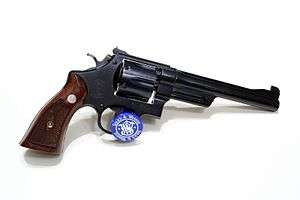Smith & Wesson .38/44
| Smith & Wesson .38/44 | |
|---|---|
|
A post-war .38/44 Outdoorsman | |
| Type | Revolver |
| Place of origin | United States |
| Production history | |
| Manufacturer | Smith & Wesson |
| Produced | 1930–1966[1] |
| Variants |
Heavy Duty Outdoorsman Model 20 Model 23 |
| Specifications | |
| Weight | 40 ounces (1.1 kg)[2] |
| Barrel length | |
|
| |
| Cartridge | .38 Special[1] |
| Action | Double-action[1] |
| Feed system | Six-round cylinder[1] |
Smith & Wesson .38/44 identifies a series of Smith & Wesson N-frame revolvers chambered for the .38 Special cartridge loaded to higher pressures than were considered appropriate for earlier revolvers of that caliber. High-pressure .38/44 loadings represent a transition between conventional .38 Special ammunition and the .357 Magnum. Revolvers were manufactured from 1930 to 1941, and after World War II until lower-priced .357 Magnum revolvers became widely available.
History
Inability of conventional police service revolver ammunition to reliably penetrate automobiles was perceived as a problem as United States law enforcement agencies encountered organized crime funded by Bootlegging in response to prohibition.[1] In 1930, Smith & Wesson chambered their large framed .44 Special revolver for .38 Special with a 5-inch (13 cm) barrel and fixed sights intended for police use, the Smith & Wesson .38/44 Heavy Duty.[3][4] The following year, Remington Arms produced high speed .38 Special loadings headstamped .38-44; and Smith & Wesson began production of the Smith & Wesson .38/44 Outdoorsman with a 6.5-inch (17 cm) barrel and adjustable sights in 1931.[1] Western Cartridge Company introduced .38 Special cartridges firing a 158-grain (10.2 g) metal-penetrating copper-tipped lead-alloy bullet at 1,125 feet (343 m) per second[5] in comparison to 755 feet (230 m) per second for conventional .38 Special ammunition.[1] A 4-inch (10 cm) barrel was offered in 1935 for users willing to accept the reduced ballistic performance of a more compact firearm.[2] The media attention gathered by the .38/44 and its ammunition encouraged Smith & Wesson to develop the longer .357 Magnum cartridge in 1935.
The .38/44 was an option for purchasers unwilling to pay the premium pricing of .357 Magnum revolvers. Revolvers were available with either blue or nickel finish. Production was interrupted by the second world war. Postwar production serial numbers are prefixed with the letter S.[1] After the war these N-frame revolvers were popular with veterans experimentally handloading the .38 Special at pressures up to fifty percent higher than the 15,000 pounds per square inch (1,000 atm) recommended for conventional revolvers.[6] The Outdoorsman with adjustable sights became the Smith & Wesson Model 23 after 1957 and the fixed sight Heavy Duty version was marketed as the Smith & Wesson Model 20.[1]
References
- 1 2 3 4 5 6 7 8 9 10 11 12 Hacker, Rick (2014). "Smith & Wesson .38/44 Heavy Duty". American Rifleman. National Rifle Association. 162 (February): 92.
- 1 2 "SMITH AND WESSON'S 38-44 HEAVY DUTY". 1Aspenhill. Retrieved 26 January 2014.
- ↑ Shideler, Dan, Is This the Greatest .38 Ever, Gun Digest, 4 August 2008
- ↑ Sharpe, Phil, The New Smith & Wesson Heavy Duty .38, The American Rifleman, November 1931
- ↑ Western Ammunition Handbook (3rd ed.). East Alton, Illinois: Western Cartridge Company. pp. 54–63.
- ↑ Barr, Al; Teesdale, Jerald; Keith, Elmer; Hardaway, Ben F. (1951). Reloading Information. 2. Washington DC: National Rifle Association. pp. 71–75.

